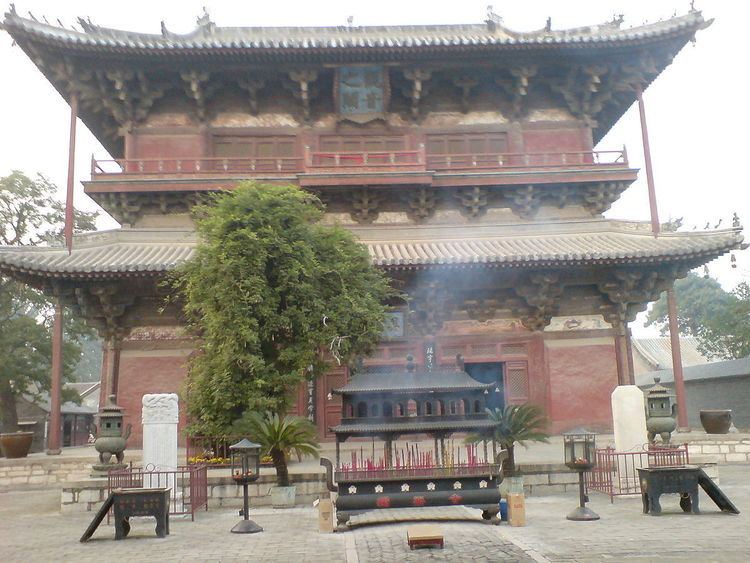Completed 984 CELiao Dynasty Opened 984 AD | Affiliation Buddhist Height 23 m Phone +86 22 2914 2904 | |
 | ||
Province Municipality of Tianjin Address 41号 Wuding St, Jixian, China, 301900 Similar Huangya Pass, Mount Pan, Guwenhua Jie, Tianjin Water Park, Temple of Great Compassion | ||
Dule temple great gate nio
The Dule Temple (Chinese: 独乐寺; pinyin: Dúlè Sì; literally: "Temple of Solitary Joy") is a Buddhist temple located in the town of Jixian, in Ji County, under the administration of the city of Tianjin, China. The temple is of historical as well as architectural significance. Its oldest surviving buildings are two timber-frame structures, the front gate and the central hall (pavilion) that houses a colossal clay statue of the goddess Guanyin (Avalokiteśvara). Both structures date back to the Liao Dynasty and are among the oldest surviving wooden buildings in China.
Contents
History
The origins of the Dule Temple date back at least to the early Tang Dynasty. However, no buildings from the Tang Dynasty era have survived on the site. The oldest buildings still in existence, the Shan Gate and the Guanyin Pavilion, were constructed during a renovation of the temple in the second year of Tonghe Emperor of the Liao Dynasty (984 AD). These buildings, both central features of the temple, were designed and constructed by local architects and craftsmen on the basis of the Tang architectural technology and carving techniques.
In 755, An Lushan held a rally in the Dule Temple at the onset of his rebellion against the Tang emperor. The name of the temple could be a reference to An Lushan, who was also known as An Dule. However, the name could also have originated from the Dule River that flows to northwest of the city, although it is not clear if the river's name predates that of the temple.
In 1928, a unit of soldiers commanded by warlord Sun Dianying was stationed in the Dule Temple and used the main hall as barracks. Sun Dianying and his troops were responsible for the looting of the nearby Eastern Qing Tombs. A leftover from the military occupation of the temple are bullet holes in the timber frames that were inflicted during target practice.
In the early 1930s, Dule Temple was studied by Liang Sicheng, the author of the China's first modern history on Chinese architecture. In the same decade, the temple was converted into the Jixian Village Normal School.
Site Description
The Shan Gate (Chinese: 山门; pinyin: Shānmén; literally: "Hill Gate") is a single-story building that stands 10 meters tall and has three single-eaves Wudian roofs (Chinese: 庑殿顶; pinyin: Wǔdiàn dǐng, i.e., roofs with four slopes and five ridges). It functions as the front gate on the temple's south side and houses the statues of two guardian kings.
The Guanyin Pavilion (Chinese: 观音阁; pinyin: Guānyīn Gé) is a three-story timber structure with five single-eaves Xieshan roofs (Chinese: 歇山顶; pinyin: Xiēshān dǐng, i.e., half-hipped, half-gabled) roofs. The pavilion has a height of about 23 meters and consists of more than one thousand individual pieces. Inside the hall there is a clay statue of Guanyin with the heads of ten small Buddhas visible on its crown (Chinese: 十一面观音塑像; pinyin: Shíyī Miàn Guānyīn Sùxiàng; literally: "Eleven-face Guanyin clay sculpture"). The statue, measuring 16 meters in height, is the biggest of its kind in ancient China.
World Heritage status
The site was added to the UNESCO World Heritage Tentative List on in the Cultural category.
Location
The Dule Temple is located in the center of the town of Jixian (Chinese: 蓟县城; pinyin: Jìxiàn Chéng). Its address is Wuting Street 41, Jixian, Tianjin City (Chinese: 天津市蓟县城内武定街41号; pinyin: Tiānjīn Shì Jìxiàn Chéngnèi Wǔdìng Jiē 41 hào).
